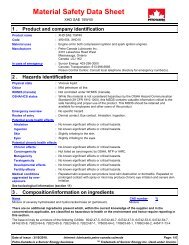0057 GASOLINE, UNLEADED (English (GB)) PC MSDS NA 4.0.5 ...
0057 GASOLINE, UNLEADED (English (GB)) PC MSDS NA 4.0.5 ...
0057 GASOLINE, UNLEADED (English (GB)) PC MSDS NA 4.0.5 ...
You also want an ePaper? Increase the reach of your titles
YUMPU automatically turns print PDFs into web optimized ePapers that Google loves.
<strong>GASOLINE</strong>, <strong>UNLEADED</strong> Page Number: 4<br />
7 .<br />
Handling and storage<br />
Storage :<br />
8 .<br />
closed when not in use. Store and use away from heat, sparks, open flame or any other<br />
ignition source. Use explosion-proof electrical (ventilating, lighting and material<br />
handling) equipment. Use non-sparking tools. Take precautionary measures against<br />
electrostatic discharges. To avoid fire or explosion, dissipate static electricity during<br />
transfer by earthing and bonding containers and equipment before transferring material.<br />
Empty containers retain product residue and can be hazardous. Do not reuse container.<br />
Store in accordance with local regulations. Store in a segregated and approved area.<br />
Store in original container protected from direct sunlight in a dry, cool and well-ventilated<br />
area, away from incompatible materials (see section 10) and food and drink. Eliminate<br />
all ignition sources. Separate from oxidizing materials. Keep container tightly closed<br />
and sealed until ready for use. Containers that have been opened must be carefully<br />
resealed and kept upright to prevent leakage. Do not store in unlabelled containers.<br />
Use appropriate containment to avoid environmental contamination. Ensure the storage<br />
containers are grounded/bonded.<br />
Exposure controls/personal protection<br />
Ingredient<br />
Gasoline<br />
Toluene<br />
Benzene<br />
Ethanol<br />
Exposure limits<br />
ACGIH TLV (United States).<br />
TWA: 300 ppm 8 hour(s).<br />
STEL: 500 ppm 15 minute(s).<br />
ACGIH TLV (United States).<br />
TWA: 20 ppm 8 hour(s).<br />
ACGIH TLV (United States). Absorbed through skin.<br />
TWA: 0.5 ppm 8 hour(s).<br />
STEL: 2.5 ppm 15 minute(s).<br />
ACGIH TLV (United States).<br />
STEL: 1000 ppm 15 minute(s).<br />
Consult local authorities for acceptable exposure limits.<br />
Recommended monitoring<br />
procedures<br />
Engineering measures<br />
Hygiene measures<br />
Personal protection<br />
Respiratory<br />
: If this product contains ingredients with exposure limits, personal, workplace atmosphere<br />
or biological monitoring may be required to determine the effectiveness of the ventilation<br />
or other control measures and/or the necessity to use respiratory protective equipment.<br />
: Use only with adequate ventilation. Use process enclosures, local exhaust ventilation or<br />
other engineering controls to keep worker exposure to airborne contaminants below any<br />
recommended or statutory limits. The engineering controls also need to keep gas,<br />
vapour or dust concentrations below any lower explosive limits. Use explosion-proof<br />
ventilation equipment.<br />
: Wash hands, forearms and face thoroughly after handling chemical products, before<br />
eating, smoking and using the lavatory and at the end of the working period. Appropriate<br />
techniques should be used to remove potentially contaminated clothing. Wash<br />
contaminated clothing before reusing. Ensure that eyewash stations and safety showers<br />
are close to the workstation location.<br />
:<br />
Use a properly fitted, air-purifying or air-fed respirator complying with an approved<br />
standard if a risk assessment indicates this is necessary. Respirator selection must be<br />
based on known or anticipated exposure levels, the hazards of the product and the safe<br />
working limits of the selected respirator. Recommended: A NIOSH-approved airpurifying<br />
respirator with an organic vapour cartridge or canister may be permissible<br />
under certain circumstances where airborne concentrations are expected to exceed<br />
exposure limits. Protection provided by air-purifying respirators is limited. Use a<br />
positive-pressure, air-supplied respirator if there is any potential for uncontrolled release,<br />
exposure levels are unknown, or any other circumstances where air-purifying respirators<br />
may not provide adequate protection.<br />
Date of issue : 10/10/2012. Internet: www.petro-canada.ca/msds Page: 4/8<br />
Petro-Canada is a Suncor Energy business<br />
TM<br />
Trademark of Suncor Energy Inc. Used under licence.

















